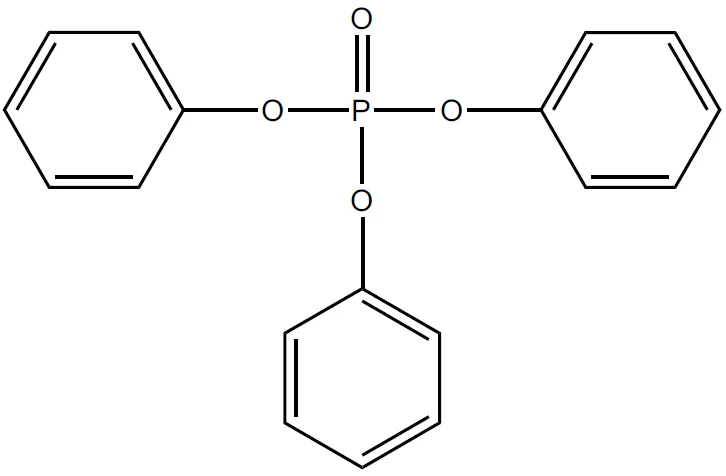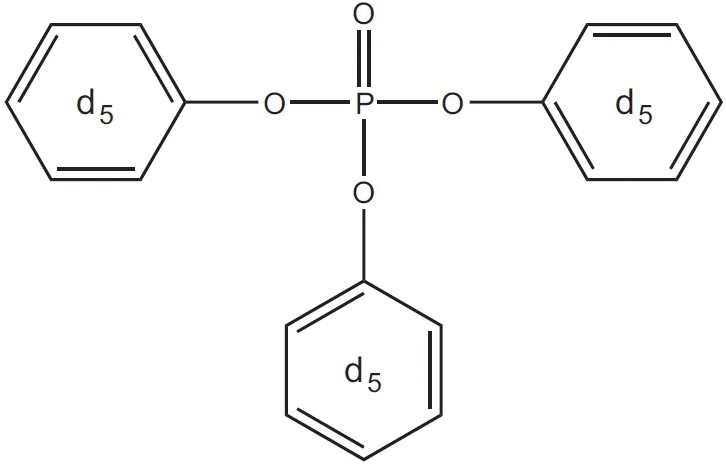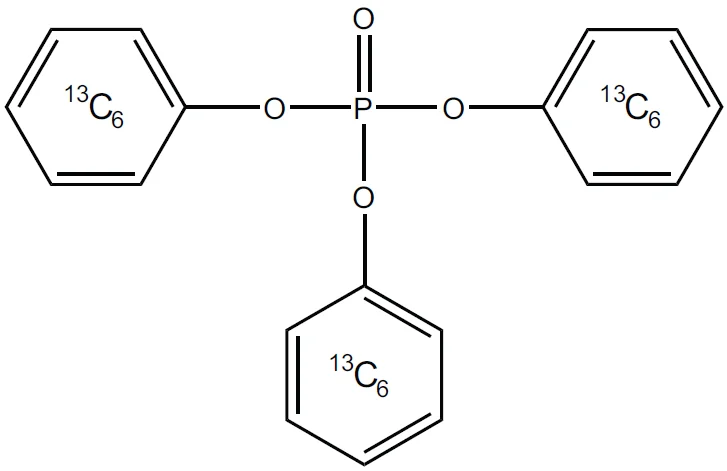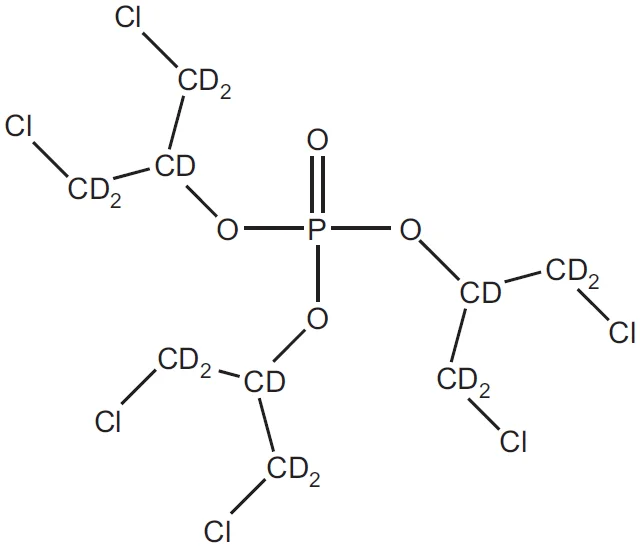Organophosphorus compounds
Our range of organophosphorus compounds for your environmental analyses.Discover our native, mass-labelled or deuterated organophosphorus compound standards.
Trust BCP Instruments for all your analytical standards needs and benefit from the excellence of Wellington Laboratories products in France and Belgium.
Home | Wellington Analytical Standards | HFRs and Related Compounds | Organophosphorus Compounds
Our analytical standards for organophosphorus compounds
The individual solutions of organophosphorus compounds developed by Wellington Laboratories are certified standard solutions designed specifically for the analysis of flame retardants.
They are used as reference materials for the analysis, quantification and validation of analytical methods using chromatography coupled with mass spectrometry, as part of regulatory or environmental controls.
All our CRMs are available in 1.2 mL solutions in toluene or acetonitrile, and are ISO 9001, ISO/IEC 17025 and ISO 17034 certified.
Native organophosphorus compounds
Standards for 13C-labelled or deuterated organophosphorus compounds
Our commitments
Haute précision
Ces solutions innovantes permettent une identification et une quantification fiables des composés cibles grâce à leur pureté exceptionnelle et à leur compatibilité optimale avec les protocoles analytiques.
Conçus pour répondre aux exigences rigoureuses des laboratoires, nos standards de référence offrent une performance analytique inégalée, assurant ainsi des résultats reproductibles et conformes aux standards réglementaires les plus stricts. Avec les produits Wellington, vous bénéficiez d’outils de référence pour mener des analyses environnementales de pointe.
Fiabilité certifiée
Chaque lot est accompagné d’un certificat d’analyse détaillé, attestant de la qualité et de la pureté des composés.
Livraison rapide
France et Belgique.
Do you have a question? Contact us using the contact form. We will be delighted to advise you.
Organophosphorus compounds individual solutions
Composés organophosphorés natifs
Solutions individuelles natives
| Catalogue No. | Description | Solvent | CAS |
|---|---|---|---|
| TPP | Triphenyl phosphate | toluene | 115-86-6 |
| TOTP | Tri-o-tolyl phosphate | toluene | 78-30-8 |
| TMTP | Tri-m-tolyl phosphate | toluene | 563-04-2 |
| TPTP | Tri-p-tolyl phosphate | toluene | 78-32-0 |
| B2tBPPP | Bis(2-tert-butylphenyl) phenyl phosphate | toluene | 65652-41-7 |
| B3tBPPP | Bis(3-tert-butylphenyl) phenyl phosphate | toluene | N/A |
| B4tBPPP | Bis(4-tert-butylphenyl) phenyl phosphate | toluene | 115-87-7 |
| 2tBPDPP | 2-tert-Butylphenyl diphenyl phosphate | toluene | N/A |
| 3tBPDPP | 3-tert-Butylphenyl diphenyl phosphate | toluene | N/A |
| 4tBPDPP | 4-tert-Butylphenyl diphenyl phosphate | toluene | 981-40-8 |
| T3tBPP | Tris(3-tert-butylphenyl) phosphate | toluene | N/A |
| T4tBPP | Tris(4-tert-butylphenyl) phosphate | toluene | 78-33-1 |
| T24DtBPP | Tris(2,4-di-tert-butylphenyl) phosphate | toluene | 95906-11-9 |
| T2IPPP | Tris(2-isopropylphenyl) phosphate | toluene | 64532-95-2 |
| T3IPPP | Tris(3-isopropylphenyl) phosphate | toluene | 72668-27-0 |
| T4IPPP | Tris(4-isopropylphenyl) phosphate | toluene | 2502-15-0 |
| T34DMPP | Tris(3,4-dimethylphenyl) phosphate | toluene | 716912 |
| T35DMPP | Tris(3,5-dimethylphenyl) phosphate | toluene | 25653-16-1 |
| B24DIPPPP | Bis(2,4-diisopropylphenyl) phenyl phosphate | toluene | 2190501-29-0 |
| B2IPPPP | Bis(2-isopropylphenyl) phenyl phosphate | toluene | 69500-29-4 |
| B3IPPPP | Bis(3-isopropylphenyl) phenyl phosphate | toluene | 69500-30-7 |
| B4IPPPP | Bis(4-isopropylphenyl) phenyl phosphate | toluene | 55864-07-8 |
| 2IPPDPP | 2-Isopropylphenyl diphenyl phosphate | toluene | 64532-94-1 |
| 3IPPDPP | 3-Isopropylphenyl diphenyl phosphate | toluene | 69515-46-4 |
| 4IPPDPP | 4-isopropylphenyl diphenyl phosphate | toluene | 55864-04-5 |
| 24DIPPDPP | 2,4-Diisopropylphenyl diphenyl phosphate | toluene | 96107-55-0 |
| TEP | Triethyl phosphate | toluene | 78-40-0 |
| TPrP | Tri-n-propyl phosphate | toluene | 513-08-6 |
| TBP | Tri-n-butyl phosphate | toluene | 126-73-8 |
| TBEP | Tris(2-butoxyethyl) phosphate | toluene | 78-51-3 |
| TDBPP | Tris(2,3-dibromopropyl) phosphate | toluene | 126-72-7 |
| EHDP | 2-Ethylhexyl diphenyl phosphate | toluene | 1241-94-7 |
| TEHP | Tris(2-ethylhexyl) phosphate | toluene | 78-42-2 |
| TCEP | Tris(2-chloroethyl) phosphate | toluene | 115-96-8 |
| TCPP | Tris[(2R)-1-chloro-2-propyl] phosphate | toluene | 13674-84-5 |
| BDCP | Bis(1,3-dichloro-2-propyl) phosphate | acetonitrile | 72236-72-7 |
| TDCPP | Tris(1,3-dichloro-2-propyl) phosphate | toluene | 13674-87-8 |
N/A: not applicable
Conditionnement
1.2 mL x 50ug/mL
Fabricant
Wellington Laboratories
Disponibilité & commande
Nous contacter

![TCPP Tris[(2R)-1-chloro-2-propyl] phosphate 115-96-8 TCPP Tris[(2R)-1-chloro-2-propyl] phosphate 115-96-8 - composés organophosphorés - BCP Instruments](https://bcp-instruments.com/wp-content/uploads/2025/07/TCPP.webp)

Composés organophosphorés marqués
Solutions individuelles marquées 13C ou deutérées
| Catalogue No. | Description | Solvent | CAS |
|---|---|---|---|
| MTPP | (13C18)Triphenyl phosphate | toluene | N/A |
| dTPP | Triphenyl phosphate-d15 | toluene | 1173020-30-8 |
| dTEP | Triethyl phosphate-d15 | toluene | 135942-11-9 |
| dTPrP | Tri-n-propyl phosphate-d21 | toluene | 1219794-92-9 |
| dTBP | Tri-n-butyl phosphate-d27 | toluene | 61196-26-7 |
| M6TBEP | Tris[2-butoxy(13C2)ethyl] phosphate | toluene | N/A |
| dTCEP | Tris(2-chloroethyl) phosphate-d12 | toluene | 1276500-47-0 |
| dBDCP | Bis(1,3-dichloro-2-propyl) phosphate-d10 | acetonitrile | N/A |
| dTDCPP | Tris(1,3-dichloro-2-propyl) phosphate-d15 | toluene | 1447569-77-8 |
N/A: not applicable
Conditionnement
1.2 mL x 50ug/mL
Fabricant
Wellington Laboratories
Disponibilité & commande
Nous contacter



Do you have a question? Contact us using the contact form. We will be delighted to advise you.

PFAS, per- polyfluoroalkyl Substances

Halogenated flame retardants, HFRs and other compounds

Polychlorinated biphenyls, PCBs

Polybrominated diphenyl ethers, PBDEs Polybrominated biphenyls, PBBs

Dioxins, Furans, PCDDs, PCDFs

Organochlorine Pesticides, OCP

Certified reference materials

Other reagents
Find out more about organophosphorus compounds
Les composés organophosphorés sont des composés organiques contenant au moins un atome de phosphore.
Applications et utilisations
Les composés organophosphorés sont largement utilisés comme pesticides, retardateurs de flamme, et agents de guerre chimique. Par exemple, le malathion est un pesticide couramment utilisé, tandis que le sarin et le VX sont des agents neurotoxiques utilisés comme armes chimiques.
Impact environnemental et toxicité
Bien que certains composés organophosphorés soient efficaces et moins persistants que les hydrocarbures chlorés, ils peuvent être extrêmement toxiques pour les humains et les animaux. Leur utilisation nécessite des précautions strictes pour éviter les effets néfastes sur la santé et l’environnement.
Réglementation en France
En France, les composés organophosphorés sont soumis à des réglementations strictes pour limiter leur impact sur la santé et l’environnement. Le programme national de biosurveillance Esteban a mesuré les niveaux d’imprégnation par les pesticides organophosphorés dans la population française. La fabrication industrielle de composés organophosphorés est également réglementée, avec des restrictions sur les substances et mélanges dangereux.
Réglementation en Belgique
En Belgique, la réglementation est alignée sur les directives européennes, notamment le règlement REACH (CE n° 1907/2006) et le règlement sur les polluants organiques persistants (UE 2019/1021). L’arrêté royal du 16 novembre 2023 a modifié le code du bien-être au travail pour inclure des valeurs limites d’exposition professionnelle plus strictes pour certains agents chimiques, y compris les composés organophosphorés.
Do you need laboratory equipment and/or consumables?
Feel free to contact us at any time.
